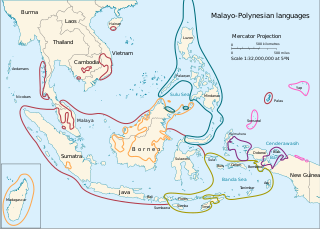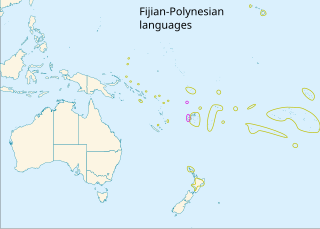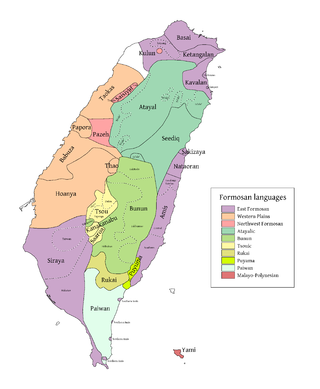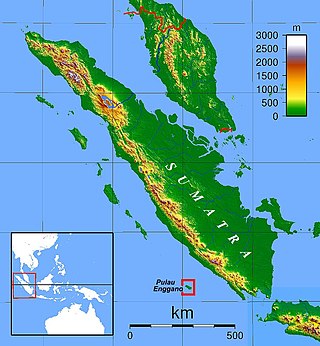Related Research Articles

The Malayo-Polynesian languages are a subgroup of the Austronesian languages, with approximately 385.5 million speakers. The Malayo-Polynesian languages are spoken by the Austronesian peoples outside of Taiwan, in the island nations of Southeast Asia and the Pacific Ocean, with a smaller number in continental Asia in the areas near the Malay Peninsula, with Cambodia, Vietnam and the Chinese island Hainan as the northwest geographic outlier. Malagasy, spoken in the island of Madagascar off the eastern coast of Africa in the Indian Ocean, is the furthest western outlier.

The Polynesian languages form a genealogical group of languages, itself part of the Oceanic branch of the Austronesian family.

The Chimakuan languages are a group of extinct languages that were spoken in northwestern Washington state, United States, on the Olympic Peninsula. They were spoken by Chimakum, Quileute and Hoh tribes. They are part of the Mosan sprachbund, and one of its languages is famous for having no nasal consonants. The two languages were about as close as English and German. Due to proximity, the Chimakuan languages are also similar to Wakashan.
The nine South Vanuatu languages form a family of the Southern Oceanic languages, spoken in Tafea Province of Vanuatu.
The Meso-Melanesian languages are a linkage of Oceanic languages spoken in the large Melanesian islands of New Ireland and the Solomon Islands east of New Guinea. Bali is one of the most conservative languages.
Sakao is an Oceanic language spoken on the northeast horn of Espiritu Santo, Vanuatu.
Vitu or Muduapa is an Oceanic language spoken by about 7,000 people on the islands northwest of the coast of West New Britain in Papua New Guinea.
Proto-Oceanic is a proto-language that historical linguists since Otto Dempwolff have reconstructed as the hypothetical common ancestor of the Oceanic subgroup of the Austronesian language family. Proto-Oceanic is a descendant of the Proto-Austronesian language (PAN), the common ancestor of the Austronesian languages.
The Wuvulu-Aua language is an Austronesian language which is spoken on the Wuvulu and Aua Islands and in the Manus Province of Papua New Guinea.
Proto-Austronesian is a proto-language. It is the reconstructed ancestor of the Austronesian languages, one of the world's major language families. Proto-Austronesian is assumed to have begun to diversify c. 4000 BCE – c. 3500 BCE in Taiwan.
Mota is an Oceanic language spoken by about 750 people on Mota island, in the Banks Islands of Vanuatu. It is the most conservative Torres–Banks language, and the only one to keep its inherited five-vowel system intact while also preserving most final vowels.
An echo vowel, also known as a synharmonic vowel, is a paragogic vowel that repeats the final vowel in a word in speech. For example, in Chumash, when a word ends with a glottal stop and comes at the end of an intonation unit, the final vowel is repeated after the glottal stop but is whispered and faint, as in for "arrow".

The Tsouic languages are three Formosan languages, Tsou proper and the Southern languages Kanakanavu and Saaroa. The Southern Tsouic languages of Kanakanavu and Saaroa have the smallest phonemic inventories out of all the Formosan languages, with each language having only 13 consonants and 4 vowels. These two languages are highly endangered, as many Southern Tsouic speakers are shifting to Bunun and Mandarin Chinese.

The Enggano language, or Engganese, is an Austronesian language spoken on Enggano Island off the southwestern coast of Sumatra, Indonesia.
Amarasi is a Central Malayo-Polynesian language of West Timor, and is spoken by the Amarasi. The Amarasi language has about 80,000 native speakers, with four main dialects called Ro'is, Kotos, Tais Nonof, and Ketun, though many differences exist between individual villages. It uses Subject-Object-Verb grammar structure. Speakers are interspersed with those of Helong.
The phonology of Māori is typical for a Polynesian language, with its phonetic inventory being one of the smallest in the world with considerable variation in realisation. The Māori language retains the Proto-Polynesian syllable structure: (C)V(V ), with no closed syllables. The stress pattern is unpredictable, unlike in many other Polynesian languages.

Unea Island is an island in Papua New Guinea located in the Vitu Islands. It was occupied by Japan in World War II.
Proto-Torres-Banks is the reconstructed ancestor of the seventeen languages of the Torres and Banks Islands of Vanuatu. Like all indigenous languages of Vanuatu, it belongs to the Oceanic branch of the Austronesian languages.
Proto-Admiralty Islands is the reconstructed ancestor of the Admiralty Islands languages of the Admiralty Islands, located in Papua New Guinea. It belongs to the Oceanic branch of the Austronesian languages.
Proto-Temotu is the reconstructed ancestor of the Temotu languages of Temotu Province, Solomon Islands. It belongs to the Oceanic branch of the Austronesian languages.
References
- ↑ Uneapa at Ethnologue (18th ed., 2015) (subscription required)
- ↑ Ross, Malcolm (1998). "Proto-Oceanic phonology and morphology" (PDF). In Ross, M.; Pawley, A.; Osmond, M. (eds.). The Lexicon of Proto Oceanic: The Culture and environment of ancestral Oceanic society. Vol. 1: Material Culture. Pacific Linguistics, The Australian National University. pp. 15–36. doi: 10.15144/PL-C152.15 . C-152. Retrieved 14 February 2022.
- Lynch, John; Malcolm Ross; Terry Crowley (2002). The Oceanic languages. Richmond, Surrey: Curzon. ISBN 978-0-7007-1128-4. OCLC 48929366.